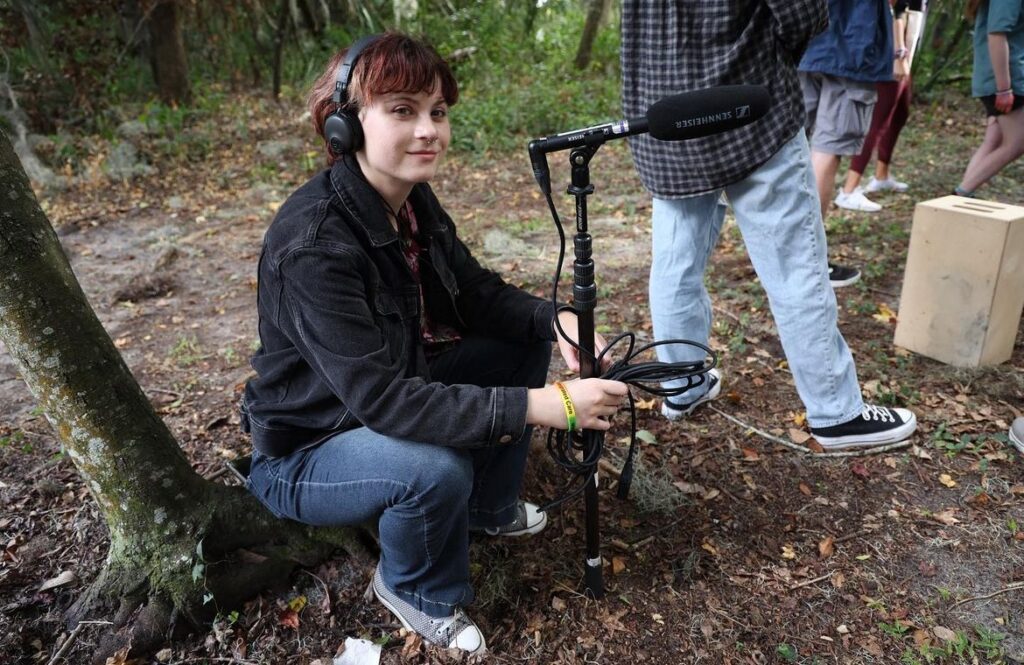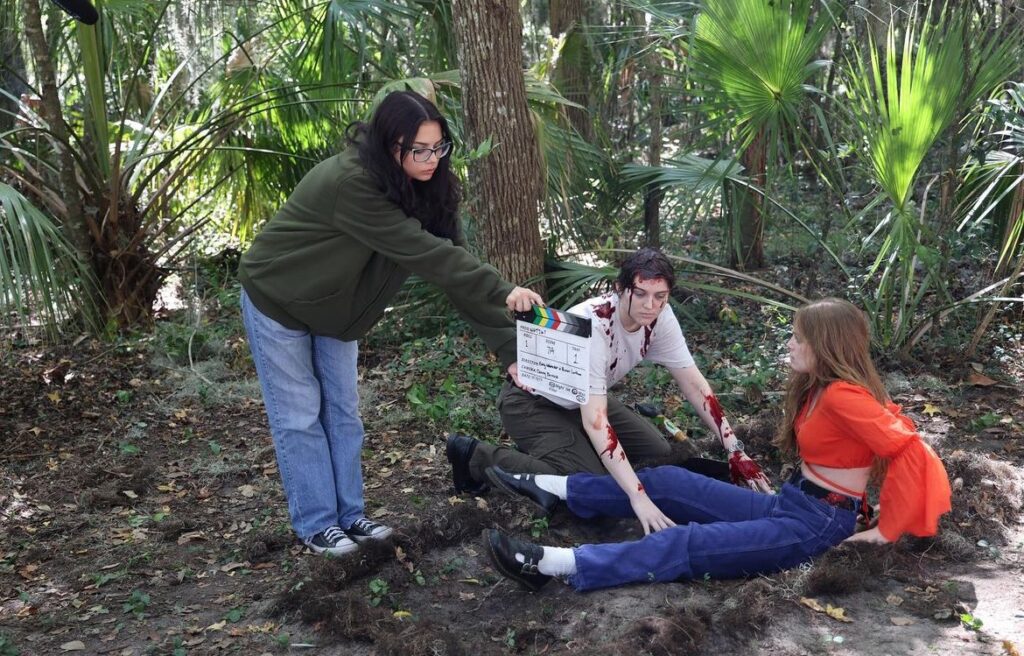A female-led film club creates community and challenges stereotypes in a difficult industry.

Sofia Dinka holds a microphone for F.E.M.’s Halloween short film. Members often switch roles for different films to gain new experiences. (Photo courtesy of Azhalia Pottinger/F.E.M. Films)
April 10, 2024 | Story by Kylie Williams
In a secluded stretch of woods, two teenage girls struggle to wheel a green metal wagon behind them.
Susie is blond, wide-eyed and naive, while the other girl, Vik, is dark-skinned, tough and wearing all black. They heave the wagon along the uneven dirt path; it’s heavy with the dead weight of an unconscious boy. The boy’s hand flops over the side, dangling and jerking with the wagon’s movements.
“I don’t know why I’m so nervous,” Susie says.
Vik pulls tabs from the pocket of her leather jacket.
“Here. This will help,” she says.
“I’ve never done —”
“Just take it. Here, I’ll show you.”
Vik puts a tab in her mouth, then gestures for Susie to open her mouth before gently placing one on her tongue.
“Atta girl. We’re almost there,” Vik says.
Susie closes her eyes, scrunching her face. The two continue along the wooded trail, cicadas chirping in the background.
“Cut!” someone yells.
The two girls simultaneously drop the wagon’s handle and their serious expressions. “Susie” coughs out a laugh, commenting on how minty the tab of Listerine is. A director, hands stained with fake blood, walks over while the boy in the back of the wagon sits up and stretches.

Christina Riolo (left) Percy Blaskowski and Madelyn French prepare for a scene’s first take in McCarty Woods. (Photo courtesy of Azhalia Pottinger/F.E.M. Films)
The set of F.E.M. Films comes alive, with roughly two dozen University of Florida students milling around the small section of McCarty Woods. F.E.M., a student-run film club in UF’s College of Journalism and Communications, has devoted the cool October weekend to shooting its Halloween short film.
This film set is different from most — not because the whole crew is under the age of 23, and not because the budget is visibly tight but because it has about three times as many women as men, a number that reflects the wider mission of the club.
F.E.M., or the Female Empowerment Machine, is an organization that elevates women’s voices and perspectives, in an industry that seems to prioritize the opposite.
Nadia Cox, co-president of F.E.M., watches the buzzing hive of the set from the background. Cox, who has been co-president since 2022, took on a supporting role for the shoot, helping younger club members or providing advice when needed.
Film shoots can be stressful, Cox said, which is why she tries to create an environment based in equality. Getting snippy or yelling at other members isn’t tolerated, and although there’s a crew hierarchy, F.E.M. members are told to treat everyone with the same courtesy.
“Having that sense of mutual respect, admiration and a love of filmmaking will take people far in the industry,” Cox, a senior media production, management and technology major, said.
The film industry is notorious for being cutthroat, she said, and is difficult to pursue a career in. Employees are often expected to work 12-hour days on a measly salary, usually in cities like Los Angeles or New York where the cost of living is high. The problem of employee mistreatment is only exacerbated for women, Cox added.
“We still have those stereotypes of ‘Women are fragile. They can’t work these long hours. They can’t do this,’” she said.
According to research from San Diego University, which annually tracks female roles off-screen in the top 250 highest grossing films, women are sorely underrepresented. In 2022, women comprised 18% of directors, 19% of writers, 7% of cinematographers, 25% of executive producers and 21% of editors.
F.E.M. appears to be the opposite of these national statistics. The club is led by two female co-presidents. The directors, the actors and the producers on set are almost all women. In an almost laughable picture of irony, one of the only men on set, Rowen Frick, spends the shoot holding a tray of Starbucks coffee.
Frick darts around set whilst offering up lattes, a task that would probably be considered a woman’s job on a real film set. Frick, however, doesn’t seem to mind. He jokes with the crew often, and doesn’t cringe when the director of photography, another man, yells out the command “Coffee!” Even though F.E.M. is female dominated, Frick didn’t feel too intimidated to become part of the club, he said.

Ben Gancarz-Davies suited up in camera equipment for F.E.M.’s shoot. Although the club is female-centered, it has multiple male members. (Photo courtesy of Azhalia Pottinger/F.E.M. Films)
“They made it a point where they’re like, ‘We accept everyone’” he said. “I love film, so I thought I would join.”
When Kris Torres founded F.E.M. Films in 2018, she did it to fill gaps. Torres had joined other film clubs on campus, she said, and found them all to have the same competitive nature. She wanted an organization that had a community aspect, where members were focused on collaborating with each other.
Torres, who graduated in 2019, also realized that students interested in media production weren’t able to get their hands on a camera until their junior year. In film, Torres said, you have to learn by doing. She wanted to create a club where underclassmen could learn how to use camera equipment and gain experience. When Torres first started F.E.M., she was teaching members on her own personal camera and trying to convince other girls with cameras to do the same.
“If you have that access, it’s your job to open the door for the next person,” she said.
Torres founded F.E.M. as an inclusive space for people of all backgrounds, even though the emphasis was on female voices. She chose not to apply for any funding from UF Student Government, a policy that the current presidents still honor.
Torres, who has often taken an activist role, said that she’s experienced censorship in other UF-funded organizations when speaking out on important topics. She had previously made a video for the student government-funded organization Students Taking Action Against Racism, in which she included content about systemic racism on UF’s campus. The video, Torres said, was never shown due to its content.
Film can be a powerful storytelling tool, Torres said, and she wanted F.E.M. to be a place where people could speak out about issues that mattered to them. The organization is completely self-reliant through methods such as fundraising, club dues and screening events. The club needs roughly $400-$600 every year to stay solvent, a goal it’s usually able to meet. Active club members pay $5 in dues, and the club holds screening events of their short films throughout the semester as a fundraiser.
For a film club, the budget is incredibly low — but it’s a sacrifice that F.E.M.’s presidents are willing to make for the club’s autonomy.
“If the school funds the project, they control the narrative,” Torres said. “If I’m gonna put my savings into it, you can’t tell me what to do.”
When Torres decided she wanted to start F.E.M., she went to her professor and mentor Iman Zawahry to sponsor the organization. The pioneer of the film specialization within the media production, management and technology major, Zawahry was well-versed in the hurdles that come with a career in film.
Zawahry, a Muslim American woman, said she’s spent her life fighting against the grain. While there have been some positive changes in the past decade, she said, sexism within the industry is still very apparent. Disparities in pay, employers choosing to hire men over women and female ideas getting shot down in a professional setting are all issues that Zawahry calls “the usual.”
While Zawahry was doing theatrical tours for her debut film “Americanish” over the summer, SAG-AFTRA and WGA labor strikes broke out. Citing low wages and unfair treatment, screen writers and other off-screen employees joined together in one of their biggest strikes in decades. Zawahry, who had many friends involved in the strike, said that the promotion of her film was harmed by the strikes.
Zawahry’s film was contracted through Sony, a major company that had many workers involved in the strike. Due to the rules of the strike, SAG-AFTRA and WGA members couldn’t promote Zawahry’s film. Zawahry also couldn’t move forward with any other projects or pitches and had to change how her film was released. However, Zawahry still stood with those in the industry that chose to strike.
“People were losing health insurance, not able to eat,” she said. “But they stuck to their guns.”
As the only hijabi muslim woman in the College of Journalism and Communications, Zawahry said she fell into a mentor role for female college students interested in film. While film is a difficult industry to go into, Zawahry said she advises young filmmakers on how to be successful.
The most important thing, she said, is to find a community.
“Your people do not have to look like you or be you,” she explained. “They just have to be supportive and understanding and uplift you.”
For many female film students at UF, that community is found in F.E.M.
Sarah Simon, a senior media production, management and technology student, said she wouldn’t have chosen a career in film without F.E.M. Throughout her first few years at UF, Simon changed her major six times.
When she first started attending F.E.M. meetings at the beginning of her junior year, Simon said she was drawn to the warmth and friendliness of the club.
Simon said she enjoyed how F.E.M. chose to lift up female voices, particularly women of color. As a Black woman, Simon grew up without seeing herself reflected on the big screen. When she writes short films now, Simon says she’s writing stories with characters and representation that other young women of color would like to see.
“I’m writing for seven-year-old Sarah, who would have loved to watch something like this,” she said.
Simon, who wants to one day direct her own film, acknowledges the potential hurdles that she’ll have to face within the industry. Still, she said she believes the industry is changing. In the past few years, F.E.M. has consistently had 20-30 members. At their first general body meeting of the Fall 2023 semester, roughly 60 people showed up. Most of these new members were freshmen, Simon said, a sign that the club is growing.
“The more we uplift these women in film, the more change will happen,” she said.
In McCarty woods, the time between takes of the club’s horror short is full of laughter and chatter. As Vik tucks the Listerine tabs back in her pocket, and the crew scurries behind the camera for the next take, Cox and other members of the crew prepare for the next scene.
Although there’s still hours left in the shoot, F.E.M. ‘s members show no sign of slowing down. The club’s mutual passion for film and sense of community create a joyful energy, one that drives F.E.M. forward through the day — and hopefully, through the industry.

A photo of F.E.M.’s Spring 2024 crew, taken March 3. (Photo courtesy of Azhalia Pottinger/F.E.M. Films)